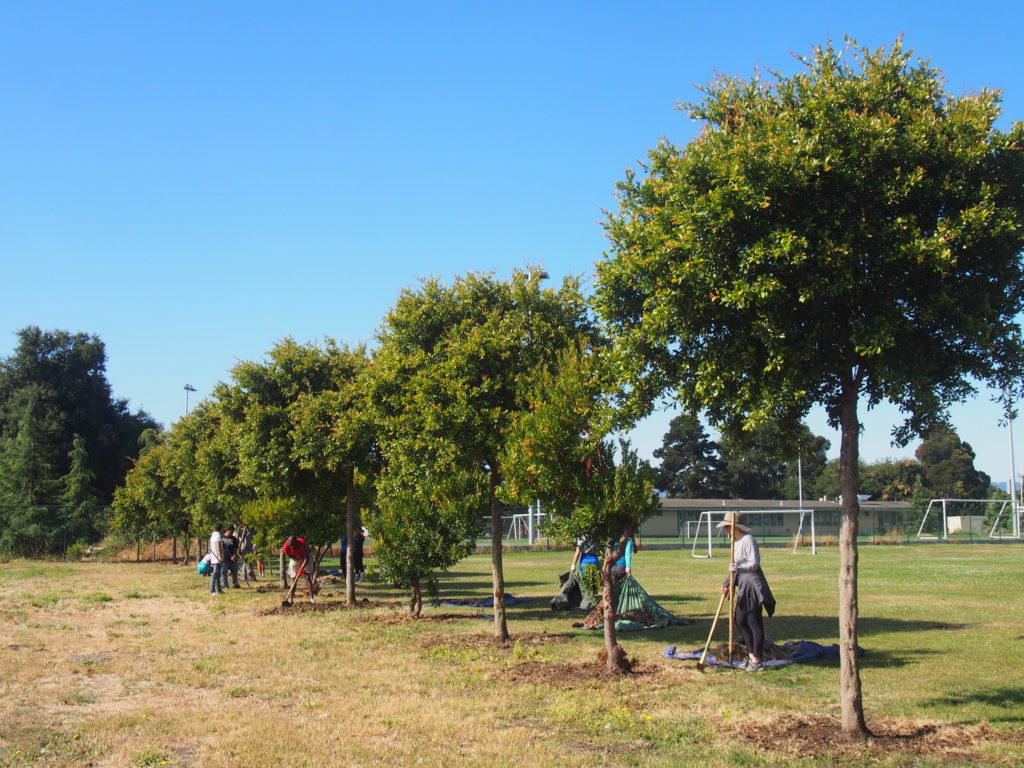- About Us
- Our Work
- Tree Info
- Get Involved
- Blog
- Support Us
By Canopy Team on August 12, 2019

Welcome to Canopy’s Ask the Arborist blog series that features tree care tips and expert advice from local certified arborists.
Some tree care professionals recommend fertilizing all trees on an annual basis, claiming this keeps them healthy. They say their fertilizers are specially formulated to meet trees’ nutritional needs, and that regular fertilization makes trees more resilient to stress. It sounds like a great proposition.
Trees do grow faster when they’re fertilized, so that must mean they’re healthy, right? Not necessarily!
Fast growth does not equal happy plants. Excess nitrogen promotes the growth of twigs and leaves at the expense of root growth. This can reduce a tree’s drought tolerance in the long term, and leads to a shorter (and more expensive) pruning cycle.
In extreme cases, the branches of over-fertilized trees grow abnormally long and thin, increasing their risk for breakage. This is especially common in young trees.
As long as a tree is growing and its leaves look healthy, there are probably no nutrient deficiencies to be worried about. If foliage or twigs appear abnormal–yellow, smaller than usual, misshapen, or otherwise unusual–low soil fertility may be the culprit. Or not!
Other cultural conditions can mimic nutrient deficiency, especially improper irrigation and soil pH. In some cases, these symptoms can even be caused by excess nutrients. Girdling roots (roots wrapping around the trunk) can also cause similar symptoms.
Plant nutrients are salts, and like any other salt, large quantities can damage plants by inhibiting water intake through osmosis. For this reason, it is especially important not to fertilize drought-stressed trees. Leaf scorch is a common sign of over-fertilization, characterized by brown leaf margins and leaf drop.
Some plants, including many California natives, actually need nutrient-poor soils to thrive. While they may grow more quickly with fertilization, and may not exhibit leaf scorch, excessive soil fertility shortens their lifespans.
In addition to being bad for plants, excess fertilizer is bad for the environment. Runoff from over-fertilized residential and commercial landscapes is a major source of water pollution in the United States, despite being almost entirely preventable.
Keep in mind that lawns are usually fertilized, so a tree growing near a lawn may become over-fertilized despite receiving no intentional fertilizer application.
If nutrient deficiency is suspected, soil or leaf samples should be sent to a specialized laboratory for testing. These laboratories provide detailed prescriptions for soil amendments, if needed, which should be customized by an arborist or other landscape professional familiar with the site.
Nutrient content is just one measure of soil health, and many others are just as, if not more, important: organic matter content, aggregation, texture, pH, moisture, microbial activity, etc. While this is a complex topic, soil maintenance is, in most cases, relatively simple: retain fallen leaves, spread wood chips under trees, irrigate appropriately, and avoid inorganic and synthetic materials. Healthy soil can’t be built overnight, but there’s no better time to start than the present.
As with most things in biology, tree fertilization guidelines are not one-size-fits-all. Fruit trees should be fertilized regularly to improve fruit flavor and sugar content, and some palms require regular fertilization to stay healthy. Trees growing in enclosed planters or construction backfill usually require frequent fertilization.
Be sure to check with an arborist or other qualified landscape professional before implementing any changes in your landscape, and when in doubt, get a second opinion!
Visit Canopy’s Arborist List to find local arborists and tree care companies.
“Fertilizing Landscape Trees,” University of California Agriculture and Natural Resources Publication 8045
“Fertilizing Shade Trees,” University of Missouri Extension
“Leaf Scorch: Fact Sheet No. 2.911,” Colorado State University Extension
“Manual of California Native Plants: Soil amendments and Mulch,” Las Pilitas Nursery
“Nutrient Pollution, The Sources and Solutions: In and Around the Home,” Environmental Protection Agency
Katherine Naegele runs Aesculus Arboricultural Consulting, specializing in tree protection, tree risk assessment, and tree appraisal. In addition to being an ISA Certified Arborist, Katherine is Tree Risk Assessment Qualified and holds a Master of Forestry degree from UC Berkeley. She was on the board of Mountain View Trees for several years before it merged with Canopy, and is the current Education Chair of the Britton Fund, a nonprofit providing grant opportunities for tree research and education. When not working on or thinking about trees, she enjoys playing video and board games and perfecting her vegan cheeses.